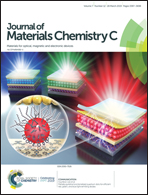Simple and efficient rhodamine-derived VO2+ and Cu2+-responsive colorimetric and reversible fluorescent chemosensors toward the design of multifunctional materials†
Abstract
A rhodamine-based derivative, (Z)-2-((3,5-dibromo-2-hydroxybenzylidene)amino)-3′,6′-bis(diethylamino)spiro-[isoindoline-1,9′-xanthen]-3-one (RhDBS), has been chosen as a representative dual chemosensor for VO2+ and Cu2+ among twenty-five Schiff-base receptors. It has been synthesized by Schiff-base condensation and characterized by standard techniques including single crystal X-ray crystallography. RhDBS can hypersensitively detect VO2+via fluorescence “off–on” type switching with a high quantum yield. Meanwhile, the chemosensor exhibits Cu2+-selective chromogenic behavior and Cu2+ ions can be detected by the naked-eye. The detection limits for VO2+ and Cu2+ have been determined to be 3.65 nM and 0.84 μM respectively, which are much lower than the allowable maxima set by the WHO, demonstrating the reliability and high efficiency of this chemosensor. Job's plot and mass spectral analysis show 1 : 1 stoichiometry between RhDBS and metal ions. RhDBS has also shown distinct responses to VO2+ through electrochemical (CV) signals. Additionally, the RhDBS·Cu2+ and RhDBS·VO2+ adducts can act as two secondary colorimetric and fluorescent sensors for pyrophosphate (PPi) anions. Advanced molecular memory devices have been constructed through these properties and interpreted. Notably, the analytical applicability of RhDBS can be further achieved by using test paper strips and silica gel plates. More excitingly, RhDBS can be resoundingly employed to trace intracellular VO2+ ions in living cells and it is the first reported smart chemosensor capable of detecting VO2+in vitro. In the solid state, RhDBS displays distinguished VO2+ and Cu2+ responsiveness along with obvious colour changes and different emission wavelengths which lead to large red shifts of the CIE-diagram. More importantly, some meaningful regular patterns are discovered for the first time through theoretical and experimental studies toward the design of multifunctional materials.



 Please wait while we load your content...
Please wait while we load your content...